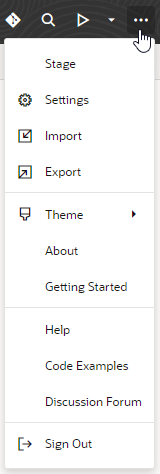Specify a Custom App URL
Sometimes it’s not appropriate to use the default URL that Visual Builder generates for your application. For example, if you’re building an application for your customers, you can use a custom domain for the application to shield customers from the details of your server’s host and domain name.
To use a custom domain for your application, your service administrator must configure your instance to support the custom domain. For the steps to do this, see Configure a Custom Endpoint for an Instance in Provisioning and Administering Oracle Integration Generation 2.
After the visual application is staged and published, the web application and the business object APIs can be accessed directly using the custom domain. You can also access web applications deployed as PWAs.
Note that only one custom domain can be mapped to a visual application, and it can only be used to access one web application in the visual application. To ensure that the correct web application is loaded when using a custom domain, your visual application must contain only one web application.
Multiple custom domains can be used in an instance, but each must be mapped to a different visual application. For example, if the visual application myvisualapp1 is mapped to the subdomain mysubdomain1, if you want to map mysubdomain2 to an application it must be mapped to a different visual application (for example, myvisualapp2).
To map a custom domain to a visual application:
After you've set the vanity URL, it's important you work with the visual app using its custom domain. For example, if the app's vanity URL is https://foo.example.org, access it in a browser at https://foo.example.org/ic/builder, then proceed to stage and publish the app.
Note:
Working with a vanity app from a non-vanity host can cause issues when you try to access the deployed app, so make sure you access the Designer using the app's custom domain.After you publish the visual application, a visitor can enter the custom domain (for example, https://foo.example.org) in the browser to open the web application. The URL will not contain any additional path parameters because the app is loaded as the root domain.

